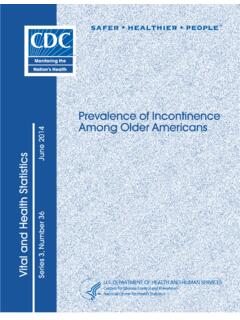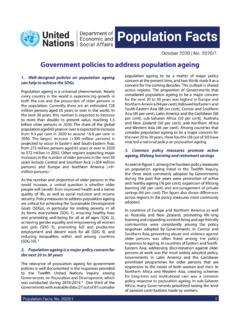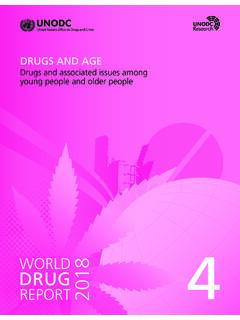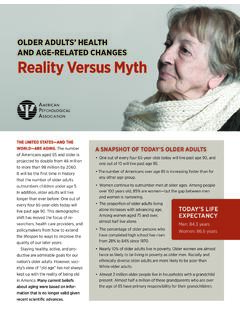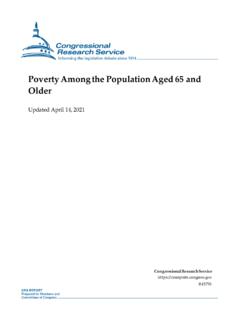Transcription of 2016 Older Americans - Aging Stats
1 2016 Older Americans Key Indicators of Well-Being Federal Interagency Forum on Aging -Related Statistics The Federal Interagency Forum on Aging -Related Statistics (Forum) was founded in 1986 to foster collaboration among Federal agencies that produce or use statistical data on the Older population. Forum agencies as of June 2016 are listed below. Consumer Product Safety Commission Department of Housing and Urban Development Department of Commerce Census Bureau Department of Labor Bureau of Labor Statistics Department of Health and Human Services Administration for Community Living Employee Benefits Security Administration Agency for Healthcare Research and Quality Department of Veterans Affairs Centers for Medicare and Medicaid Services Environmental Protection Agency National Center for Health Statistics Office of Management and Budget Office of Statistical and Science Policy National Institute on Aging Social Security Administration Office of the Assistant Secretary for Planning and Office of Research, Evaluation, and Statistics Evaluation Substance Abuse and Mental Health Services Administration Copyright information.
2 All material appearing in this report is in the public domain and may be reproduced or copied without permission; citation as to source, however, is appreciated. Recommended citation: Federal Interagency Forum on Aging -Related Statistics. Older Americans 2016: Key Indicators of Well-Being. Federal Interagency Forum on Aging -Related Statistics. Washington, DC: Government Printing Office. August 2016. Report availability: Single copies of this report are available at no charge through the National Center for Health Statistics while supplies last. Requests may be sent to the Information Dissemination Staff, National Center for Health Statistics, 3311 Toledo Road, Room 5412, Hyattsville, MD 20782. Copies may also be ordered by calling 1-866-441-NCHS (6247) or by e-mailing This report is also available on the World Wide Web at Older Americans 2016.
3 Key Indicators of Well-Being Foreword Older Americans (those age 65 and over) are a vibrant The SPM extends the official poverty measure by taking and growing part of our Nation. They also experience into account many government programs designed to unique challenges to their economic well-being, health, assist low-income families that are not included in the and independence. To inform decisions regarding the official poverty measure. support and well-being of Older Americans , robust Although Federal agencies currently collect and report statistics reflecting these experiences are needed. Although substantial information on the population age 65 and many Federal agencies provide statistics on aspects of over, other important gaps in our knowledge remain. Older Americans ' lives, it can be difficult to fit the pieces In Older Americans 2012, the Forum identified six such together into a comprehensive representation.
4 Thus, it has areas where more data are needed: informal caregiving, become increasingly important for policymakers and the residential care, elder abuse, functioning and disability, general public to have an accessible, easy-to-understand mental health and cognitive functioning, pension portrait of how Older Americans fare. measures, and end-of-life issues. In Older Americans 2016, Older Americans 2016: Key Indicators of Well-Being we provide updated information on the data availability ( Older Americans 2016) provides a comprehensive, for these specific areas, in addition to a special feature on easy-to-understand picture of our Older population. It informal caregiving. is the seventh such chartbook prepared by the Federal We continue to appreciate users' requests for greater detail Interagency Forum on Aging -Related Statistics (Forum).
5 For many existing indicators. We also extend an invitation Readers will find here an accessible compendium of to all of our readers and partners to let us know what else indicators drawn from the most reliable official statistics. we can do to make our reports more accessible and useful. Indicators are categorized into six broad groups: Please send any comments to Population, Economics, Health Status, Health Risks and Behaviors, Health Care, and Environment. The Older Americans reports reflect the Forum's commitment to advancing our understanding of where The Forum's recent review of the Older Americans Older Americans stand today and what challenges they chartbook resulted in the addition of several new may face tomorrow. I congratulate the Forum agencies indicators particularly relevant to many of the challenges for joining together to present the American people with currently facing Older Americans .
6 among these additions such valuable tools for understanding the well-being of the are an indicator describing the changing demographics of Older population. Last, but not least, none of this work Social Security beneficiaries and an indicator describing would be possible without the continued cooperation of transportation access for Older Americans . Indicators have millions of American citizens who willingly provide the also been added to describe dementia rates (including data that are summarized and analyzed by staff in the Alzheimer's disease rates, among the non-nursing home Federal agencies for the American people. population) as well as to examine the number of Older Americans receiving long-term care by different types Katherine K. Wallman of providers. Finally, the Supplemental Poverty Measure Chief Statistician (SPM) for Americans age 65 and over has been added.
7 Office of Management and Budget iii Acknowledgments Older Americans 2016: Key Indicators of Well-Being is a ASPE; Jennifer Park, OMB; Beth Han, and Jennifer report of the Federal Interagency Forum on Aging -Related Solomon, SAMHSA; Howard Iams and Brad Trenkamp, Statistics (Forum). This report was prepared by the Forum's SSA; Hazel Hiza, USDA; and Carolyn Stoesen,VA. planning committee and reviewed by the Forum's principal In addition to the 16 agencies of the Forum, the members, which include Vicki Gottlich and Robert Department of Agriculture (USDA) was invited to Hornyak (retired), Administration for Community Living contribute to this report. The Forum greatly appreciates (ACL); Steven B. Cohen, Agency for Healthcare Research the efforts of Hazel Hiza and TusaRebecca Schap, Center and Quality (AHRQ); Dorinda Allard, Bureau of Labor for Nutrition Policy and Promotion, USDA, in providing Statistics (BLS); Karen Humes and Roberto Ramirez, valuable information from their agency.
8 Other staff Census Bureau; Debra Reed-Gillette, Centers for Medicare members of Federal agencies who provided data and & Medicaid Services (CMS); Kathleen Stralka, assistance include Jennifer Klocinski, ACL; Rachel Krantz- Consumer Product Safety Commission (CPSC); Lynn Kent and Geoffrey Paulin, BLS; William Dean, Maria Ross, Department of Housing and Urban Development Diacogiannis, Deborah Kidd, Chris McCormick, Maggie (HUD); Joseph Piacentini and Anja Decressin, Employee Murgolo, Joseph Regan, and Laura Saffron, CMS; Ellen Benefits Security Administration (EBSA); Kathy Sykes, Baldridge, David Mintz, and Rhonda Thompson, EPA;. Environmental Protection Agency (EPA); Charles Rothwell Carolyn Lynch, HUD; Elizabeth Arias, Robin Cohen, and Jennifer Madans, National Center for Health Statistics Nazik Elgaddal, Ginny Freid, Lauren Harris-Kojetin, (NCHS); John Haaga and John Phillips, National Institute Cynthia L.
9 Ogden, Eunice Park-Lee, and Manisha on Aging (NIA); Ruth Katz and William Marton, Office Sengupta, NCHS; Vicky Cahan, NIA; Lynn Fisher, SSA;. of the Assistant Secretary for Planning and Evaluation and Peter Ahn and Tom Garin, VA. (ASPE), Department of Health and Human Services;. Katherine K. Wallman, Office of Management and Budget The Forum is also indebted to the people outside the (OMB); Daryl Kade, Substance Abuse and Mental Health Federal government who contributed to this chartbook: Services Administration (SAMHSA); Howard Iams, Social Gwen Fisher, Cathy Liebowitz, and David Weir, University Security Administration (SSA); and Dat Tran and Richard of Michigan; and Xianfen Li, Harris Corporation. Allman, Department of Veterans Affairs (VA). Member agencies of the Forum provided funds and The Forum's planning committee and contributing staff valuable staff time to produce this report.
10 NCHS and members include Forum Staff Director, Traci Cook; Susan its contractor, American Institutes for Research (AIR), Jenkins and Kristen Robinson, ACL; David Kashihara facilitated the production, printing, and dissemination AHRQ; Emy Sok, BLS; Amy Symens Smith and Wan He, of this report. Melissa Diliberti, Ashley Roberts, Katie Census Bureau; Kathleen Stralka, CPSC; Katherine Mallory, Susan Armstrong, and Kathryn Low managed Giuriceo and Lisa Mirel, CMS; Meena Bavan, HUD; the report's production process and designed the layout;. Allan Beckmann and Lynn Shniper, EBSA; Kathy Sykes, Richard Devens, First XV Communications, provided EPA; Julie Dawson Weeks and Ellen Kramarow, NCHS; consultation and editing services. John Phillips, and Prisca Fall, NIA; Helen Zayac Lamont, iv About This Report Introduction One or more charts that illustrate important aspects of the data.


